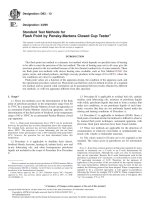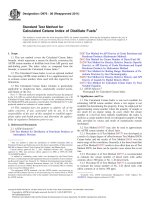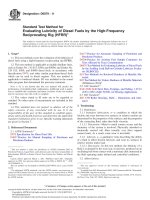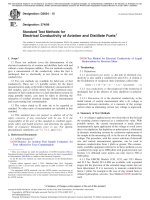ASTM D38-94 (2000) e1 Standard Test Methods for Sampling Wood Preservatives Prior to Testing
Bạn đang xem bản rút gọn của tài liệu. Xem và tải ngay bản đầy đủ của tài liệu tại đây (82.38 KB, 6 trang )
Designation: D 38 – 94 (Reapproved 2000)e1
Standard Test Methods for
Sampling Wood Preservatives Prior to Testing1
This standard is issued under the fixed designation D 38; the number immediately following the designation indicates the year of original
adoption or, in the case of revision, the year of last revision. A number in parentheses indicates the year of last reapproval. A superscript
epsilon (e) indicates an editorial change since the last revision or reapproval.
e1 NOTE—A keyword was added editorially in March 2000.
1. Scope D 168 Test Method for Coke Residue of Creosote3
D 246 Test Method for Distillation of Creosote and
1.1 These test methods cover sampling of creosote,
creosote-coal tar solutions, creosote-petroleum solutions, and Creosote-Coal Tar Solutions3
oilborne and waterborne preservatives. D 346 Practice for Collection and Preparation of Coke
NOTE 1—See Specification D 390, for Coal-Tar Creosote for the Samples for Laboratory Analysis4
Preservative Treatment of Piles, Poles, and Timbers for Marine, Land, and D 367 Test Method for Xylene-Insoluble Matter in Creo-
Fresh Water Use,2 Specification D 391 for Creosote-Coal Tar Solution,2
and Specification D 1858, for Creosote-Petroleum Solution.2 sote3
D 368 Test Method for Specific Gravity of Creosote and
1.1.1 Creosote and creosote solutions are homogeneous
liquids, except for their moisture content. At atmospheric Oil-Type Preservatives3
temperatures, however, part of the creosote is usually in D 369 Test Method for Specific Gravity of Creosote Frac-
crystalline form, and shall be heated to a temperature at which
it is entirely liquid before sampling. tions and Residues3
D 370 Test Method for Dehydration of Oil-Type Preserva-
1.1.1.1 When sampling creosote and creosote solutions, the
object is to obtain a sample that will be representative of the tives3
water content, and the methods of sampling described are D 1033 Methods of Chemical Analysis of Chromated Zinc
intended to accomplish that purpose.
Chloride3
1.1.2 Recommended test methods are given for sampling a D 1035 Test Methods for Chemical Analysis of Fluor-
preservative in a liquid or solid state and in the several types of
containers in which they are likely to be encountered. Creosote, Chrome-Arsenate-Phenol3
creosote-coal tar, and creosote-petroleum solutions may be in D 1274 Test Methods for Chemical Analysis of Pentachlo-
the form of a liquid or semiliquid. Oilborne and waterborne
preservatives may be in the solid state, in concentrated solu- rophenol3
tions, or in ready-to-use solutions. D 1326 Methods for Chemical Analysis of Ammoniacal
1.2 This standard does not purport to address all of the Copper Arsenate3
safety concerns, if any, associated with its use. It is the D 1627 Methods for Chemical Analysis of Acid Copper
responsibility of the user of this standard to establish appro-
priate safety and health practices and determine the applica- Chromate3
bility of regulatory limitations prior to use. D 1628 Test Methods for Chemical Analysis of Chromated
2. Referenced Documents Copper Arsenate3
D 3176 Practice for Ultimate Analysis of Coal and Coke4
2.1 ASTM Standards: D 3180 Practice for Calculating Coal and Coke Analyses
D 95 Test Method for Water in Petroleum Products and
from As-Determined to Different Bases4
Bituminous Materials by Distillation2
3. Significance and Use
1 These test methods are under the jurisdiction of ASTM Committee D07 on
Wood and are the direct responsibility of Subcommittee D07.06 on Treatments for 3.1 The test methods described are for use in obtaining
Wood Products. representative samples of wood preservatives under most
phases of shipment, use, or storage. Since these materials may
Current edition approved July 15, 1994. Published September 1994. Originally have to be sampled under varying conditions, it is not possible
published as D 38 – 15 T. Last previous edition D 38 – 79 (1989). to provide a definite standard for each type of wood preserva-
tive under every sampling condition. Individual cases may
2 Annual Book of ASTM Standards, Vol 05.01. have to be worked out by the sampler on the basis of
judgement, skill, and experience. The basic principle of each
3 Annual Book of ASTM Standards, Vol 04.10.
4 Annual Book of ASTM Standards, Vol 05.05.
Copyright © ASTM International, 100 Barr Harbor Drive, PO Box C700, West Conshohocken, PA 19428-2959, United States.
1
D 38 – 94 (2000)e1
method, however, is to obtain a sample or a composite of
several samples in such manner and from such locations in the
container that the sample or composite will be truly represen-
tative of the material being sampled.
4. Apparatus Metric Equivalents
4.1 Continuous-Drip Sampling: mm 6.4 9.5
4.1.1 Line Connection constructed substantially as shown
in Fig. 1 shall be inserted in the pipeline through which the in. 1⁄4 3⁄8
preservative is being transferred, preferably on the discharge
side of the pump. The sampling pipe shall be provided with a FIG. 1 Continuous Sampling Connection
valve.
4.1.2 Receiver—Use a clean, dry container of convenient 4.5 Tube Sampling:
size to receive the sample. The container shall be covered with 4.5.1 Glass or Metal Tube, designed so that it will reach to
a lid to protect the sample from foreign contamination. within 3 mm (1⁄8 in.) of the bottom of the container. A metal
Creosote, creosote-coal tar solutions, and creosote-petroleum tube for sampling 208-L (55-gal) drums is shown in Fig. 6.
solutions may become semisolid as they cool in the sample 4.6 Tap Sampling:
container during the course of the sampling. These samples 4.6.1 Standard Pipe, with a suitable valve is satisfactory.
should be heated to complete liquidity before taking an aliquot The valve should be equipped with a delivery tube which will
for testing. not contaminate or affect the product being sampled.
4.2 Zone Sampling:
4.2.1 Sampling Bottle (see Figs. 2 and 3) with a 19-mm 5. Procedure
(3⁄4-in.) diameter opening.
4.3 Thief Sampling: 5.1 Recommended Sampling Methods:
4.3.1 For sampling liquids or semiliquids in tank cars, tank 5.1.1 See recommended methods for sampling creosote and
trucks, and storage tanks, use a sampling devise designed so creosote solutions in Table 1.
that a sample can be obtained within 13 mm (1⁄2in.) of the 5.1.2 See recommended methods for sampling oilborne and
bottom of the vessel used. A sampling thief for this purpose is waterborne preservatives in Table 2.
illustrated in Fig. 4. 5.2 Continuous Drip Sampling—Use this method of sam-
4.3.2 For sampling granular material loose carried in bags, pling wherever a liquid is being loaded or discharged from a
drums, or boxes, use a solids thief sampler 38 mm (11⁄2 in.) in
diameter and a least 457 mm (18 in.) long similar to that shown
in Fig. 5.
4.4 Grab Sampling:
4.4.1 Shovel or Scoop, with a width at least twice as great as
the maximum dimension of the largest pieces sampled and a
sample container suitable for the product being sampled.
TABLE 1 Sampling of Creosote and Creosote SolutionsA
Shipping, Treating or Storage Time of Sampling Preferred Sampling Type of Sample Size of Sample to be Additional Instructions
to be Sampled Method Taken from Each
Container
Ship and barge tanks immediately after loading bottle or beaker all-levels sample approximately 3 gal Gage free water separately if
Tank cars and tank trucks 1 gal creosote is not agitated
or prior to unloading sampling composite of upper thoroughly.
middle and lower 1–8 gal depending
immediately after loading bottle or beaker samples on size of tank Gage free water separately if
creosote is not agitated
or prior to unloading sampling all-levels sample 1–3 gal depending thoroughly. Use Table 1 to
on size of tank determine proportions of
Vertical storage and working whenever required for bottle or beaker composite of upper, subsamples in composite
tanks inventory or other sampling middle and lower 1 gal sample.
purposes samples 1 gal
Horizontal storage and working bottle or beaker Gage free water separately if
tanks whenever required for sampling tap sample creosote is not agitated
inventory or other all-levels sample thoroughly.
purposes
Gage free water separately if
Pressure treating cylinders immediately after cylinder tap sampling creosote is not agitated
Non-pressure treating vats is filled thoroughly. Use Table 1 to
bottle or beaker determine proportions of
immediately after vat is sampling subsamples in composite
filled for cold bath sample.
...
...
A When the sample is taken the temperature of the material should be at least 150°F and the material should be completely liquefied and thoroughly agitated.
2
D 38 – 94 (2000)e1
Metric Equivalents
mm 3.2 7.9 67 84 127
in. 1⁄8 5⁄16 25⁄8 35⁄16 5
FIG. 2 Weighted Bottle
vessel by means of pumping. Obtain the sample from a pipe Metric Equivalents
line conveying the product in such manner as to give a
representative average of the stream throughout the period of mm 25.4 3.2 70 76 83 102 254 349
transit.
in. 1 1⁄8 23⁄4 3 31⁄4 4 10 133⁄4
5.2.1 Insert a 1⁄4-in. sampling pipe in the line through which
the liquid preservative is being pumped, on the discharge side kg 0.50
of the pump and preferably in a rising section of the pipe line.
Extend this sampling pipe halfway to the center of the main oz 18
pipe, with the inner open end of the sampling pipe turned at an
angle of 1.57 radius (90°) and facing the flow of the liquid. FIG. 3 Weighted Beaker
Provide the sampling pipe with a valve and discharge it into a
receiver of 4 to 19-L (1 to 5-gal) capacity. Clean the sampling as possible to the selected draw-off level, then open the
pipe of foreign material by quickly collecting and discarding sampler, allowing the sample container to fill at that point, and
the first 500 mL of discharge. slowly withdraw it.
5.2.2 Adjust the valve so that with a steady continuous drip 5.3.1 Obtain three samples. Take each in a similar manner,
of the preservative the receiver will be filled in the time with the sampling apparatus lowered to the point selected as
required to pump the entire quantity of material being trans- the following zones (Table 3):
ferred.
Upper zone obtained from the middle of the upper third of the vessel
5.2.3 Immediately upon completion of the pumping, thor- contents.
oughly mix the contents of the receiver by agitation (heat to Middle zone
complete liquidity if necessary), rolling, or shaking, and Lower zone obtained from the middle of the vessel contents.
immediately take duplicate 1-L (1-qt) samples for the purpose obtained from the middle of the lower third of the vessel
of testing. Do not collect less than 4 L (1 gal) of drop samples
except in the case of large volumes, such as boat shipments, contents.
where a maximum of 19 L (5-gal) is sufficient.
5.3.2 The individual samples may be analyzed separately or
5.3 Zone Sampling—Use this method of sampling to sample composited for testing. If composited, combine the three
liquid-wood preservatives in tank cars, storage tanks, tank samples (Table 3) and mix at once while the material is
trucks and trailers, work tanks, ship tanks, and barge tanks. thoroughly liquid. Take no sample for analysis from material
Semiliquid materials, which can be heated until sufficiently that contains crystals.
fluid, may be sampled by this procedure. Thoroughly agitate
creosote and solutions of creosote with coal tar or petroleum 5.4 Thief Sampling—Use this method of sampling to obtain
and heat to 65 to 93°C (150 to 200°F) to effect solution. Obtain bottom samples of liquids or semiliquids from tank cars, and
the sample by submerging a closed sampler to a point as near storage tanks, by means of the liquid thief apparatus, and to
obtain samples of granular material in bags, drums, or boxes,
by means of the solids thief apparatus.
3
D 38 – 94 (2000)e1
Metric Equiva-
lents
mm 9.5 83 914
in. 3⁄8 11⁄4 36
FIG. 6 Thief for Sampling Drums
Metric Equivalents
mm 64 89 203 267 5.5.1 The sample that is taken with a shovel or scoop from
bulk material shall be at least 0.01 % of the total, but not less
in. 21⁄2 31⁄2 8 101⁄2 than 2.3 kg (5 lb) nor more than 45 kg (100 lb).
FIG. 4 Thief for Sampling Tank Cars 5.5.2 When sampling solids in bags or barrels, obtain a
single sample from each of several packages selected at
Metric Equivalents random as indicated in Table 4.
mm 38 457 5.5.3 Thoroughly blend the samples together and reduce the
combined quantity to a convenient laboratory size by the
in. 11⁄2 18 quartering procedure illustrated in Practice D 346, or with a
riffle sampler as described in Practice D 3176 and Practice
FIG. 5 Solids or Bag Thief D 3180.
5.4.1 For sampling liquids or semiliquids, lower the clean, 5.6 Tube Sampling—Use the tube sampling procedure to
dry thief (see 4.3.1) through the dome of the tank car or tank sample liquids and semiliquids in drums and cans.
hatch until it strikes the bottom. When full, remove the thief
and transfer the contents to the sample container. Close and 5.6.1 Place the drum on its side with the bung up. If the
label the container immediately and deliver it to the laboratory. drum does not have a side bung, stand it upright and sample
Agitate oil-type preservatives such as creosote, coal tar, petro- from the top. Close the upper end of the clean, dry sampling
leum and their solutions, and heat to the temperature necessary tube with the thumb, and lower the tube into the material for a
to effect complete liquidity prior to sampling. depth of about 305 mm (1 ft).
5.4.2 To sample solid granular material, force the solids 5.6.2 Remove the thumb, allowing liquid to flow into the
thief sampler (see 4.3.2) completely through the body of the tube. Again close the upper end with the thumb and withdraw
material in each package at the following locations: One at the the tube. Rinse the tube with the material by holding it nearly
center; one 1⁄4 the diameter or width from the right side, and horizontal and turning it so that the liquid comes in contact
one at 1⁄4 the diameter or width from the left side. Put the three with that part of the inside surface which will be immersed
sets of samples in individual containers, label, and deliver them when the sample is taken. Allow the tube to drain and discard
to the laboratory (see 5.7). the rinse oil.
5.5 Grab Sampling—Use this method of sampling to 5.6.3 Insert the tube into the material again, holding the
sample a quantity of loose granular, or lumpy solids in bins, thumb against the upper end. When the tube reaches the desired
bunkers, barrels, bags, boxes, and conveyors. depth, remove the thumb and allow the tube to fill. Replace the
thumb, withdraw the tube quickly, and transfer the contents to
a labeled container.
5.6.4 When sampling cans of 19-L (5-gal) capacity, a tube
sampler of proportionately smaller dimensions may be used.
4
D 38 – 94 (2000)e1
TABLE 2 Sampling of Oilborne and Waterborne Preservatives
(In Solid State, Concentrated Solutions, or Ready-to-Use Solutions)
Shipping, Treating or Storage Time of Sampling Preferred Sampling Type of Sample Size of Sample to be Additional Instructions
Container to be Sampled Method Taken from Each
Container
Tank cars and tank trucks
immediately after loading bottle or beaker composite of upper, 4 L (1 gal) ...
Vertical storage and working middle and lower
tanks or prior to unloading sampling samples
Horizontal storage and working whenever required for bottle or beaker all-levels sample 4 to 11 L (1–3 gal) ...
tanks inventory or other sampling
purposes composite of upper, depending on size
Pressure treating cylinders bottle or beaker middle and lower
Nonpressure treating vats whenever required for sampling samples of tank
Drums or cans of 19-L (5-gal) inventory or other
purposes tap sampling tap sample 4 to 11 L (1–3 gal) ...
capacity or larger containing
liquids immediately after cylinder bottle or beaker all-levels sample depending on size
Cans of less than 19-L (5-gal) is filled sampling
capacity containing liquids tube sample of tank
immediately after vat is tube sampling
Bins or freight cars containing filled for cold bath 4 L (1 gal) ...
loose solids
whenever required 4 L (1 gal) ...
Bags, drums, or barrels
containing solids whenever required random sampling in random sample 1 L (1 qt) Prepare composite sample in
accordance with grab sample accordance with 5.7. Select
preferably during Table 2 entire contents of cans at random in
unloading can accordance with Table 2.
grab sampling
0.1 % of total but not Prepare composite sample in
whenever required solids thief sampling thief sample less than 22.6 kg accordance with 5.7. Select
(50 lb) nor more cans at random in
than 454 kg (1000 accordance with Table 2.
lb)
Follow appropriate instructions
commensurate with in 5.4 depending on
size of thief tried whether container is being
sampled before or during
unloading.
Following instructions in 5.3.2,
select number of bags or
barrels to be sampled as
indicated in Table 2.
TABLE 3 Compositing of Samples from Horizontal Cylindrical TABLE 4 Minimum Number of Samples to be Selected from
Tanks Packaged Shipments
Liquid Depth Percent Parts of Sample to be Taken at Each Sampling Level No. of Packages No. of Samples
of Diameter
Upper Middle Lower 1 ... 1
... ... ... 1 2 to 8 2
10 ... ... 1 9 to 27 3
20 ... 3 2 28 to 64 4
30 ... 2 1 65 to 125 5
40 ... 2 1 126 to 216 6
50 ... 2 1 217 to 343 7
60 and over 1 2 1 344 to 512 8
518 to 729 9
730 to 1 000 10
1 001 to 1 331 11
1 332 to 1 728 12
For cans of less than 5-gal capacity, use the entire contents as 1 729 to 2 197 13
the sample, randomly selecting cans as indicated in Table 4.
2 198 to 2 744 14
5.7 Tap Sampling—Use the tap sampling procedure to
sample wood preservatives actually in use in pressure treating 2 745 to 3 375 15
cylinders, storage and working tanks where contents can be
properly agitated before sampling. 3 376 to 4 096 16
5.7.1 Before a sample is drawn, flush the tap and line until 4 097 to 4 193 17
they are purged completely. Connect the clean delivery tube to
the tap. 4 194 to 5 832 18
5.7.2 Draw the sample. Stopper and label the sample con- 5 833 to 6 859 19
tainer immediately after filling and deliver it to the laboratory.
6 860 to 8 000 20
6. Test Methods
8 001 to 9 261 21
6.1 To determine compliance with the appropriate specifi-
cation, the preservative shall be tested in accordance with the 9 262 to 10 648 22
following standards as appropriate.
10 649 to 12 167 23
6.1.1 Test Methods:
6.1.1.1 Coke Residue—D 168. 12 168 to 13 824 24
6.1.1.2 Distillation—D 246.
6.1.1.3 Xylene Insoluble—D 367.
6.1.1.4 Specific Gravity—D 368.
6.1.1.5 Specific Gravity of Fractions— D 369.
6.1.1.6 Water—D 95 and D 370.
6.2 Chemical Analysis:
5
6.2.1 Chromated Zinc Chloride—D 1033. D 38 – 94 (2000)e1
6.2.2 Fluor Chrome-Arsenate-Phenol—D 1035. 6.2.6 Chromated Copper Arsenate—D 1628.
6.2.3 Pentachlorophenol—D 1274.
6.2.4 Ammoniacal Copper Asenate—D 1326. 7. Keywords
6.2.5 Acid Copper Chromate—D 1627. 7.1 preservatives; sampling; wood; wood preservatives
ASTM International takes no position respecting the validity of any patent rights asserted in connection with any item mentioned
in this standard. Users of this standard are expressly advised that determination of the validity of any such patent rights, and the risk
of infringement of such rights, are entirely their own responsibility.
This standard is subject to revision at any time by the responsible technical committee and must be reviewed every five years and
if not revised, either reapproved or withdrawn. Your comments are invited either for revision of this standard or for additional standards
and should be addressed to ASTM International Headquarters. Your comments will receive careful consideration at a meeting of the
responsible technical committee, which you may attend. If you feel that your comments have not received a fair hearing you should
make your views known to the ASTM Committee on Standards, at the address shown below.
This standard is copyrighted by ASTM International, 100 Barr Harbor Drive, PO Box C700, West Conshohocken, PA 19428-2959,
United States. Individual reprints (single or multiple copies) of this standard may be obtained by contacting ASTM at the above
address or at 610-832-9585 (phone), 610-832-9555 (fax), or (e-mail); or through the ASTM website
(www.astm.org).
6









